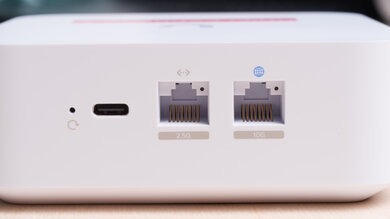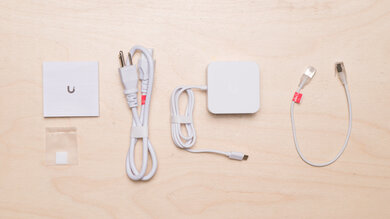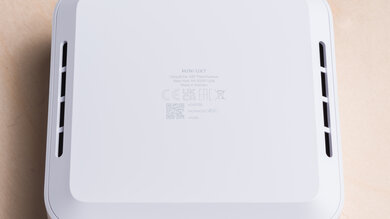The UniFi Express 7 is a compact tri-band Wi-Fi 7 router and the successor to the UniFi Express. As part of Ubiquiti's UniFi lineup, it features a host of software and hardware features that are more common on enterprise IT equipment. It has a 10Gbps WAN port, a 2.5Gbps LAN port, and a 0.96" information display on the front showing at-a-glance info like the number of devices connected to the network and speed test results. It runs UniFi's 'Network' application, a powerful software you can access via its local web server or using the UniFi mobile app. The software allows you to manage all of the UniFi devices on your network, monitor traffic in real time, and adjust settings in granular detail.
Note: We've removed the Wi-Fi coverage tests as we explore better ways to convey these results to users.
Our Verdict
The UniFi Express 7 is an excellent router for an apartment or smaller home. It has a 10Gbps WAN port and a 2.5Gbps LAN port, so you can take advantage of a multi-gigabit internet connection. That said, you'll need to purchase an additional Ethernet switch if you have many wired devices. It delivers amazing wireless speeds that are suitable for a household of users concurrently downloading, streaming, or otherwise doing bandwidth-intensive activities. While its 6GHz band has great range, the 5GHz band slows down significantly at longer distances, but that shouldn't be a big issue unless you have a very large apartment. It runs UniFi's 'Network' application, a software that allows you to manage other UniFi devices on your network, and much more. The app provides a level of control and configurability closer to an enterprise networking solution while remaining approachable and user-friendly.
-
Wi-Fi 7 support.
-
Multi-gigabit Ethernet ports.
-
Amazing top speeds.
-
Excellent 6GHz range.
-
UniFi's network application is robust and highly configurable.
-
Mediocre 5GHz range.
-
Only two Ethernet ports.
The UniFi Express 7 is a good router for a multi-level house. It delivers excellent speeds and range on its 6GHz band, but its 5GHz band slows down significantly at longer distances. Still, it delivers more than enough performance for a full household of users concurrently streaming 4k video, gaming, and downloading files. Thanks to its 10Gbps WAN port and 2.5Gbps LAN port, you can leverage a multi-gigabit internet connection, but you'll need to get an additional Ethernet switch if you have more wired devices. Additionally, it runs UniFi's 'Network' software, a robust application that offers a much higher level of configurability and control than a typical consumer router.
-
Wi-Fi 7 support.
-
Multi-gigabit Ethernet ports.
-
Amazing top speeds.
-
Excellent 6GHz range.
-
UniFi's network application is robust and highly configurable.
-
Mediocre 5GHz range.
-
Only two Ethernet ports.
The UniFi Express 7 delivers amazing speeds that are suitable for a multi-gigabit internet connection. It supports Dynamic Frequency Selection (DFS), which provides access to more channels for better speeds in congested wireless environments like apartment buildings.
-
Wi-Fi 7 support.
-
Amazing top speeds.
The UniFi Express 7 has adequate range. While its 6GHz band remains fast at longer distances, its 5GHz band slows down significantly the further away you are from the router. It's compatible with UniFi's range of wireless access points so you can easily create a mesh network.
-
Wi-Fi 7 support.
-
Excellent 6GHz range.
-
Mediocre 5GHz range.
Changelog
- Updated Jun 10, 2025: We've converted this review to Test Bench 0.8.1. This includes a new test result for our Test Configuration box.
- Updated Jun 10, 2025: Review published.
- Updated Jun 02, 2025: Early access published.
- Updated May 29, 2025: Our testers have started testing this product.
- Updated Apr 23, 2025: The product has arrived in our lab, and our testers will start evaluating it soon.
Differences Between Sizes And Variants
The UniFi Express 7 doesn't have any variants. See a picture of our unit's label.
Compared To Other Routers
The UniFi Express 7 is a tri-band Wi-Fi 7 router with a 10Gbps WAN port and a 2.5Gbps LAN port. It's the successor to the Wi-Fi 6 UniFi Express. UniFi markets it as a 'Cloud Gateway,' meaning it can function as either a Wi-Fi router, an access point with a wired backhaul, or a mesh access point with a wireless backhaul. This flexibility means it's easy to expand your wireless network if you need more coverage or want to add more UniFi devices. It uses UniFi's 'Network' application, which is robust software that lets you control a variety settings and configure your network with much more granular detail than a traditional consumer router. Unlike the UniFi Dream Router and the Dream Router 7, it doesn't support UniFi's 'Protect,' 'Talk,' and 'Access' applications for security cameras, door controls, and VOIP phones.
Its flexibility and advanced features set it apart from consumer routers, and it serves as an excellent entry point into the UniFi ecosystem at an approachable price. It also delivers excellent speeds that rival some of the fastest Wi-Fi 7 routers on the market, like the TP-Link Archer BE550 and the TP-Link Deco BE63, with the caveat that its 5GHz band underperforms at longer distances.
See our recommendations for the best long-range Wi-Fi routers, the best Wi-Fi routers, or the best routers for streaming.
The UniFi Dream Router 7 (UDR7) and the UniFi Express 7 (UX7) are tri-band Wi-Fi 7 routers with 2.4GHz, 5GHz, and 6GHz bands. They're both part of UniFi's Wi-Fi Integrated Cloud Gateway lineup and offer a robust feature set and highly configurable software for controlling your home network. The UDR7 supports a wide array of features, like UniFi's full application suite, while the UX7 only supports UniFi's 'Network' application. The UDR7 additionally features three 2.5 GbE LAN ports (one supporting PoE), a 2.5 GbE RJ45 WAN port, and a 10 GbE SFP+ WAN port, while the UX7 only has a 2.5 GbE LAN port and a 10 GbE RJ45 WAN port. Also, the UDR7 has a microSD slot with an included 64GB card for network video storage. The two deliver similar overall performance, but the UDR7's 5GHz band has better range.
The TP-Link Archer AXE75 and the UniFi Express 7 are both tri-band routers, but the former supports Wi-Fi 6E while the latter supports Wi-Fi 7. The UniFi delivers much better performance on its 6GHz band across the board, but the TP-Link has better range on it's 5GHz band. The TP-Link also has five Ethernet ports, while the UniFi has only two, albeit they're rated for much higher speeds. While the TP-Link is a consumer router with limited software configuration, the UniFi has very robust software and integration with UniFi's networking products.
The UniFi Dream Router (UDR) and the UniFi Express 7 (UX7) are both part of UniFi's Wi-Fi integrated Cloud Gateway lineup. The former is a dual-band Wi-Fi 6 router while the latter is a tri-band Wi-Fi 7 router. All five of the UDR's ports are 1 GbE, with two of them supporting PoE (Power over Ethernet), while the UX7 has a 2.5 GbE LAN port and a 10 GbE WAN port. The UDR also boasts a microSD card slot and a built-in 128GB SSD for storing network video files. While both routers support UniFi's powerful 'Network' application for managing your network, the UDR supports the entire UniFi application suite for managing security cameras, VOIP phones and more. The UX7 is much faster overall, but its 5GHz band has worse range than the UDR.
The TP-Link Archer BE550 and the UniFi Express 7 are tri-band Wi-Fi 7 routers. The TP-Link has more Ethernet ports and better range than the UniFi, but the latter has many more software features and a deep integration with UniFi's ecosystem of networking products.
Test Results
Wi-Fi 7 has faster speeds, lower latency, and supports more simultaneous connections than previous generations of Wi-Fi. However, you'll need devices supporting Wi-Fi 7 to benefit from these features.
The UX7's USB-C port is only for power and doesn't support data transfer.





